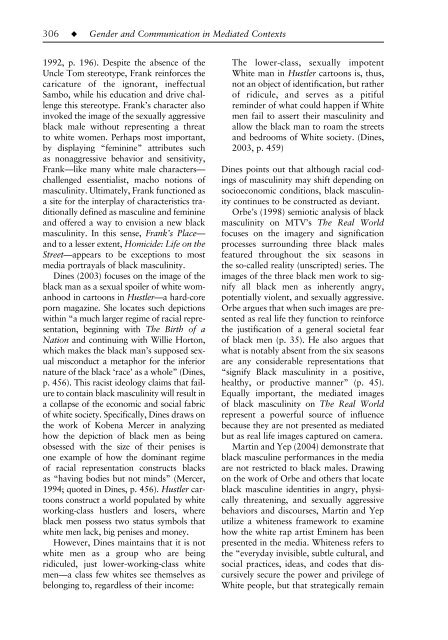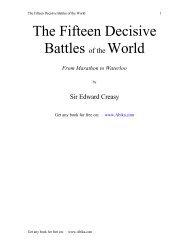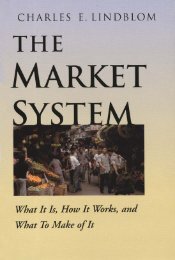Gender, race, and media representation - afghan
Gender, race, and media representation - afghan
Gender, race, and media representation - afghan
You also want an ePaper? Increase the reach of your titles
YUMPU automatically turns print PDFs into web optimized ePapers that Google loves.
16-Dow-4973.qxd 6/11/2006 1:42 PM Page 306<br />
306–––◆–––<strong>Gender</strong> <strong>and</strong> Communication in Mediated Contexts<br />
1992, p. 196). Despite the absence of the<br />
Uncle Tom stereotype, Frank reinforces the<br />
caricature of the ignorant, ineffectual<br />
Sambo, while his education <strong>and</strong> drive challenge<br />
this stereotype. Frank’s character also<br />
invoked the image of the sexually aggressive<br />
black male without representing a threat<br />
to white women. Perhaps most important,<br />
by displaying “feminine” attributes such<br />
as nonaggressive behavior <strong>and</strong> sensitivity,<br />
Frank—like many white male characters—<br />
challenged essentialist, macho notions of<br />
masculinity. Ultimately, Frank functioned as<br />
a site for the interplay of characteristics traditionally<br />
defined as masculine <strong>and</strong> feminine<br />
<strong>and</strong> offered a way to envision a new black<br />
masculinity. In this sense, Frank’s Place—<br />
<strong>and</strong> to a lesser extent, Homicide: Life on the<br />
Street—appears to be exceptions to most<br />
<strong>media</strong> portrayals of black masculinity.<br />
Dines (2003) focuses on the image of the<br />
black man as a sexual spoiler of white womanhood<br />
in cartoons in Hustler—a hard-core<br />
porn magazine. She locates such depictions<br />
within “a much larger regime of racial <strong>representation</strong>,<br />
beginning with The Birth of a<br />
Nation <strong>and</strong> continuing with Willie Horton,<br />
which makes the black man’s supposed sexual<br />
misconduct a metaphor for the inferior<br />
nature of the black ‘<strong>race</strong>’ as a whole” (Dines,<br />
p. 456). This racist ideology claims that failure<br />
to contain black masculinity will result in<br />
a collapse of the economic <strong>and</strong> social fabric<br />
of white society. Specifically, Dines draws on<br />
the work of Kobena Mercer in analyzing<br />
how the depiction of black men as being<br />
obsessed with the size of their penises is<br />
one example of how the dominant regime<br />
of racial <strong>representation</strong> constructs blacks<br />
as “having bodies but not minds” (Mercer,<br />
1994; quoted in Dines, p. 456). Hustler cartoons<br />
construct a world populated by white<br />
working-class hustlers <strong>and</strong> losers, where<br />
black men possess two status symbols that<br />
white men lack, big penises <strong>and</strong> money.<br />
However, Dines maintains that it is not<br />
white men as a group who are being<br />
ridiculed, just lower-working-class white<br />
men—a class few whites see themselves as<br />
belonging to, regardless of their income:<br />
The lower-class, sexually impotent<br />
White man in Hustler cartoons is, thus,<br />
not an object of identification, but rather<br />
of ridicule, <strong>and</strong> serves as a pitiful<br />
reminder of what could happen if White<br />
men fail to assert their masculinity <strong>and</strong><br />
allow the black man to roam the streets<br />
<strong>and</strong> bedrooms of White society. (Dines,<br />
2003, p. 459)<br />
Dines points out that although racial codings<br />
of masculinity may shift depending on<br />
socioeconomic conditions, black masculinity<br />
continues to be constructed as deviant.<br />
Orbe’s (1998) semiotic analysis of black<br />
masculinity on MTV’s The Real World<br />
focuses on the imagery <strong>and</strong> signification<br />
processes surrounding three black males<br />
featured throughout the six seasons in<br />
the so-called reality (unscripted) series. The<br />
images of the three black men work to signify<br />
all black men as inherently angry,<br />
potentially violent, <strong>and</strong> sexually aggressive.<br />
Orbe argues that when such images are presented<br />
as real life they function to reinforce<br />
the justification of a general societal fear<br />
of black men (p. 35). He also argues that<br />
what is notably absent from the six seasons<br />
are any considerable <strong>representation</strong>s that<br />
“signify Black masculinity in a positive,<br />
healthy, or productive manner” (p. 45).<br />
Equally important, the <strong>media</strong>ted images<br />
of black masculinity on The Real World<br />
represent a powerful source of influence<br />
because they are not presented as <strong>media</strong>ted<br />
but as real life images captured on camera.<br />
Martin <strong>and</strong> Yep (2004) demonstrate that<br />
black masculine performances in the <strong>media</strong><br />
are not restricted to black males. Drawing<br />
on the work of Orbe <strong>and</strong> others that locate<br />
black masculine identities in angry, physically<br />
threatening, <strong>and</strong> sexually aggressive<br />
behaviors <strong>and</strong> discourses, Martin <strong>and</strong> Yep<br />
utilize a whiteness framework to examine<br />
how the white rap artist Eminem has been<br />
presented in the <strong>media</strong>. Whiteness refers to<br />
the “everyday invisible, subtle cultural, <strong>and</strong><br />
social practices, ideas, <strong>and</strong> codes that discursively<br />
secure the power <strong>and</strong> privilege of<br />
White people, but that strategically remain




